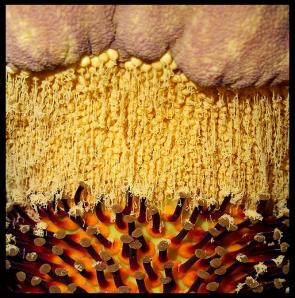Plant of the Month for November, 2012

(ah-MOR-foe-phal-us ti-TAN-um)
General Information:
The Titan arum - the largest, smelliest flower in the world.
This is not a plant for your garden, but it is a very fascinating plant. It originates in the rainforests of Sumatra and is now grown at many of the larger botanical gardens. I recently had a chance to see it in flower at the University of Guelph which has 4 mature plants.

Amorphophalus titanum; photo by Robert Pavlis
The name Amorphophalus titanum translates loosely to “giant misshapen penis”. It’s common names include Titan arum and corpse flower.
The plant is a tuber (or corm, experts don't agree) that sends up a single leaf structure which can be 6 meters (20 ft) tall and 5 meters (16 ft) across. The first plant to flower in Guelph was grown from seed by Rodger Tschanz and took 11 years to flower.
The flower has the typical arum look with a green/reddish spathe and a tan coloured spadix coming out of the center. The flower can be 9 feet tall and 3 feet wide. The so called flower is actually not a true flower, but if we consider it a flower it is the largest unbranched inflorescent in the world. The flowers are actually relatively small and are located at the bottom of the spadix.

Amorphophalus titanum; photo by Robert Pavlis
In the wild the plant flowers about every 3 years with the male flowers opening a day after the female flowers to ensure that cross pollination takes place. To make this happen the plant needs to attract pollinators from a long distance, and it has a special way to accomplish this. Firstly, it sends out a very strong foul smelling sent that attracts flies and some bees. Secondly, it heats up the spadix to vapourize the odours which makes the sent even more powerful.

Amorphophalus titanum (male flowers in the center, female at the bottom); photo from Wikipedia
The heat generating spadix (thermogenesis) is what makes this plant so interesting. We measured the temperature at 3:00 pm on the day these pictures were taken. The bottom of the plant was 24 C and the top of the spadix was 39 C. How does a plant produce such a large amount of heat? Scientists are still trying to understand this, but it seems that other arums use a chemical reaction that is similar to the one animals use to generate body heat. You could say that the arums are ‘warm blooded’ – not a completely true statement, but a close analogy.
The plants seem be fairly easy to grow in a greenhouse if you have the patience and space.
Life Cycle: perennial
Height: 6 meters (20 ft)
Bloom Time: any time
Natural Range: Sumatra
Habitat: rainforests, steep hills
Synonyms: none
Cultivation:
Light: full sun summer, shade in winter
Soil: 80 % peat
Water: water only when growing, dry when dormant
USDA Hardiness Zone: tropical
Propagation: seed
Seedex availability (ORG&HPS annual Seed Exchange): never
